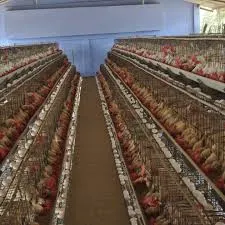poultry layer cage for sale
Dec . 21, 2024 04:58 Back to list
poultry layer cage for sale
Exploring Poultry Layer Cages for Sale A Comprehensive Guide
Poultry farming has evolved dramatically over the years, leading to advancements in the equipment and technologies used in the industry. One key component that has gained much attention is the poultry layer cage. These cages are designed specifically for laying hens and play a vital role in ensuring optimal production while promoting animal welfare. If you’re considering investing in poultry layer cages for your farm, this article aims to provide a comprehensive overview of their benefits, types, and best practices for selection.
Benefits of Poultry Layer Cages
1. Increased Egg Production Layer cages are designed to maximize space efficiency and optimize the environment for laying hens. By providing a controlled setting, these cages help reduce stress, leading to improved egg production. Hens in cages typically lay more eggs than those raised in traditional free-range systems.
2. Space Efficiency Poultry layer cages allow farmers to house a larger number of hens in a smaller area. This space-saving design not only makes it easier to manage flocks but also simplifies the logistics of feeding, watering, and cleaning the facilities.
3. Improved Biosecurity Layer cages reduce contact between birds, which minimizes the risk of disease spread. This controlled environment allows for better management of health issues, ensuring that flocks remain healthy and productive.
4. Ease of Management The design of poultry layer cages facilitates easier collection of eggs, cleaning of the cages, and monitoring of the hens. Automated systems can also be integrated for feeding and watering, reducing labor costs and enhancing productivity.
5. Enhanced Animal Welfare Modern layer cages are designed to meet higher standards of animal welfare. Many new systems provide adequate space for each bird, allow for natural behaviors such as nesting, and include perches for additional comfort.
Types of Poultry Layer Cages
When selecting poultry layer cages, it’s essential to understand the various types available
1. Traditional Cages These are typically smaller cages that hold several hens at a time. They are basic in design and provide limited space but are cost-effective and easy to operate.
2. Colony Cages Colony systems allow for a group of hens to live together in a larger cage. These setups are designed to promote better social interaction while still providing adequate space for laying eggs.
poultry layer cage for sale

3. Enriched Cages These cages go a step further by including features that allow hens to express more natural behaviors, such as nesting boxes, perches, and scratching areas. Enriched cages are becoming more popular as consumers demand higher welfare standards.
4. Free-Range Cages While technically not a cage system, free-range setups offer a compromise, allowing hens access to outdoor space while providing some of the benefits of confined housing. This system is generally more expensive but meets the preferences of certain consumer demographics.
Best Practices for Selecting Layer Cages
When shopping for poultry layer cages for sale, consider the following factors
1. Space Requirements Ensure that the cages provide adequate space per bird to meet industry regulations and welfare standards. Check local guidelines to understand the minimum requirements.
2. Ventilation and Climate Control Proper ventilation is crucial in maintaining a healthy environment for your hens. Choose cages that allow for air circulation and consider additional climate control methods for extreme temperatures.
3. Durability and Material Look for cages made of high-quality, durable materials that can withstand the test of time and the rigors of poultry farming. Stainless steel constructions are often a good choice for their longevity.
4. Ease of Access Consider how easy it is to access the cages for feeding, maintenance, and egg collection. Efficient design can save you valuable time and labor.
5. Cost vs. Quality While budget is always a factor, it’s essential to strike a balance between cost and quality. Investing in higher-quality cages may result in long-term savings through increased productivity and reduced veterinary costs.
Conclusion
Investing in poultry layer cages is a significant decision for any poultry farmer. By selecting the right type of cage and understanding the benefits it brings, you can enhance egg production, ensure the welfare of your hens, and streamline your farming operations. As the poultry industry continues to advance, staying informed about the latest trends and technology will be crucial to your success. Whether you choose traditional, colony, enriched, or free-range systems, the right poultry layer cage can make a world of difference in your farming endeavors.
-
Automatic Feeding Line System-Pan Feeder Nipple Drinker|Anping County Yize Metal Products Co., Ltd.
NewsJul.29,2025
-
Hot Sale 24 & 18 Door Rabbit Cages - Premium Breeding Solutions
NewsJul.25,2025
-
Automatic Feeding Line System Pan Feeder Nipple Drinker - Anping County Yize Metal Products Co., Ltd.
NewsJul.21,2025
-
Automatic Feeding Line System Pan Feeder Nipple Drinker - Anping County Yize Metal Products Co., Ltd.
NewsJul.21,2025
-
Automatic Feeding Line System - Anping Yize | Precision & Nipple
NewsJul.21,2025
-
Automatic Feeding Line System - Anping Yize | Precision & Nipple
NewsJul.21,2025






